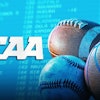During COVID-19, stuck at home and bored, two twin sisters named Haley and Hanna Cavinder began to create TikTok videos. The twins were, at the time, sophomore players on the women’s basketball team at Fresno State.
In their videos, the two dribbled basketballs to the rhythm of songs. The content became a smash hit, and by the end of the summer, the two young women had over 4 million followers across various social media platforms. When the Supreme Court ruling in Alston v. NCAA at the end of June 2021 paved the way for collegiate athletes to profit off their Name, Image, and Likeness (NIL), the Cavinder twins were one of the first to benefit.
The two young women signed a deal with Boost Mobile that plastered their image on a billboard in Times Square. They signed with Six Star Pro Nutrition, and there are other deals in the works yet to be disclosed.
NIL has created an opportunity for entrepreneurial advancement that, for years, athletes were expressly prohibited from. Some scholars have speculated that, due to the increased chance of visibility and monetization, NIL will make sports more equitable for all genders and races. But, as the first few months after the NIL ruling has shown, it is the athletes who already have media exposure and access to internet and technology who have been able to benefit first. As sports and social media continue to merge, institutions should take into consideration the ways in which equity comes into play online, and what young athletes need to learn in order to take advantage of the entrepreneurial options now available to them. Dr. Jennifer Hoffman
Dr. Jennifer Hoffman
"The early activity has revealed the places where many would have guessed that things would quickly emerge," said Dr. Jennifer Hoffman, an associate professor with the Center for Leadership in Athletics at the University of Washington, said, “ So, athletes who already have visibility because of their sport, or families with an understanding of marketing that can share that with their children, much the way many college families know how to pull the levers that propel you to a college scholarship.”
Since the pandemic began, the digital divide between urban, rural, and suburban areas has become clearer. According to the Pew Research Center, only 72% of adults in the U.S. say they have broadband internet access at home. However, roughly 80% of all surveyed owned a smart phone.
“We have to be really careful that we understand there’s wide variation in access to those tools, we can’t assume that any one person understands how to use those tools better than another based on privilege,” said Hoffman. “We don’t actually know who is highly skilled and who isn’t until they come to our campus. That’s where we need to be clear as institutions about how we’re assessing the skills students have, figuring out what we can do that’s educationally purposeful,” said Hoffman.
















